Do you want to know how much fish food per day? Too much food may make a fish ill. The animals do not devour themselves to death. In reality, they drown in their leftovers.
Because your fish may spend its whole life in 10 or 20 liters of water, the quality of that water determines whether – and for how long – they will live.
Overfeeding them can essentially poison them to death because of uneaten food and excessive nitrogenous waste generation.
However, as you read more, I will educate you on how much fish food each day is optimal for your fish.
Table of Contents
Now, let’s get started.
How Much Food Should I Feed My Fish
The kind of fish you have and the size of your tank determine how much food you should give them.
Feeding your fish only what they can finish in two to three minutes, once or twice a day, is a decent rule of thumb. Additionally, you may safely supply more food in a larger tank.
It’s crucial to avoid overfeeding your fish because this might increase the levels of ammonia and nitrite in your tank and create health problems due to water pollution.
To ascertain the ideal feeding plan and quantity for your fish, speak with your veterinarian. Remember to take into account the particular demands of your fish species.
For instance, certain fish may need a diet higher in protein than others, which may require a diet higher in plant-based foods.
How Much Food Is Too Much
As a general rule, you should only feed your fish what they can eat in three minutes. Most of the time, one meal a day is enough.
There are several exceptions to this rule, particularly when it comes to extremely young fish (fry), which typically need to be fed many times each day.
If you want to get technical, researchers have developed a method for calculating how much food each fish needs.
For example, starry gouramis, neon tetras, zebra danios, and small cichlids need to eat between 1% and 2.5% of their body weight every day.
Accordingly, 20 neon tetras (0.2 g/fish), 10 leopard danios (0.4 g/fish), and 2 moonlight gouramis (6.0 g/fish) in a 20-gram tank would mean that 20 grams of fish—or 200–500 milligrams, or 1/50th of an ounce—would require food each day.
The simplest approach to killing a fish by overfeeding is to induce the “good neighbor syndrome.”
The scenario is all too familiar: you’re going on vacation and have asked a neighbor to look after the aquarium.
They put too much food in the aquarium to keep the fish happy, creating a negative feedback loop:
- Ammonia levels increase.
- The fish become anorexic.
- The neighbor becomes concerned.
- Extra food is added to the tank.
- The fish suffer as a result.
How do you avoid the issue? Feed the fish well before you leave, and then leave them to fend for themselves until you return.
Most aquarium and pond fish can comfortably last seven to ten days without feeding (natural feeds such as bug larvae, algae, and zooplankton are readily accessible).
What Is The Number Of Feedings Per Day
The type of fish you have will determine how frequently you need to feed them. Fish can survive on just one meal a day for the most part. Some owners, nevertheless, would rather feed their fish twice a day.
Fish that are young and developing may need to eat three or more times a day. The secret is to make each feeding extremely little, regardless of the quantity.
The majority of fish can thrive on two meals each day. Except for nocturnal feeders, the time is not crucial.
Make sure to feed your nocturnal fish, like certain catfish, right before you turn out the lights at night if you have any in your tank.
They will use their acute sense of smell to locate the food as they hunt in the dark.
The once-daily feeding guideline has a few exceptions. Silver dollars, mollies, and farewells are examples of herbivores, or vegetarian fish, that have smaller stomachs and must eat often.
In the wild, they would feed on vegetation all day. They should be fed live plants to chew on or multiple tiny feedings throughout the day.
Since goldfish have no stomach, feeding them a big meal all at once is not advisable.
Since they naturally nibble on algae and other food throughout the day, it is recommended that they be served several small meals spaced out throughout the day rather than one huge meal once a day.
Fry that has just hatched and juvenile fish still developing need to be fed with special diets meant for fry more often.
How Much Should You Feed Fish A Day
“An amount they can eat in two minutes, two to three times a day” is too much food. Since they have cool blood, fish only require a little food once a day.
Once a day, they should be fed two eyes worth of food for each fish. There is little food here!
By considering the size of the tank, 1% every day equals this amount:
This estimate is really rough. It is significantly more precise to weigh the fish in grams overall and divide the result by 100 to 50. But using it is simple.
An additional useful guideline is to count the size of each fish’s eyeball and feed twice that quantity of dry food (six fish = twelve eyes of dry food) daily. Surprisingly, the rule is correct.
Note that this is for a rainbowfish, which is a “typical” fish form. When a fish has a broad body type, such as an Oscar, or a high body type, similar to a discus, its numbers are clearly larger than the approximate value.
A kitchen scale is usually necessary to weigh out the needed amount of food precisely. Occasionally, it will take five, ten, or twenty little stacks to get an exact total.
Be aware that many people believe fish has to be consumed daily. This is untrue since fish are poikilothermic or cold-blooded.
Food may be removed from aquariums for up to two weeks without causing any harm. Of course, feeding twice a day is advised if you have juveniles and you want them to grow quickly.
Upon first placement in any aquarium, particularly a quarantine tank, fish, particularly cichlids, will experience stress and fear.
Thus, they usually refuse food for a week or two at a time. This is quite normal, so don’t be concerned.
They will then need some time to adjust to a new diet. Add a tiny bit of the food you intend to offer them after about a week, and then let them consume it for several hours.
How Many Times Do I Feed My Catfish In A Day
Fry that have just hatched are often fed six to ten percent of their fish weight numerous times a day.
Broodfish are fed 1% to 2% of their body weight every day, while fingerlings are fed 2% to 5% of their body weight every day, spread out over two or more meals.
Nonetheless, during the warmer months, the majority of catfish producers feed their fish once a day, seven days a week, to satiation.
Examined the effects of feeding channel catfish raised in earthen ponds on production, feed conversion ratio (FCR), survival, weight-length relationship, percent dressout, and body composition. Feeding times included:
- Morning and evening.
- One or two times a day.
- Intermittent fasting (6 days of feeding, 1 day of fasting).
None of the four food regimens had an impact on these growth markers.
These findings imply that there is no benefit to feeding catfish more than once, feeding at a set time of day, or intermittently fasting in clay ponds when they are fed until they appear satiated.
Catfish raised in a closed recirculating raceway system showed comparable outcomes.
How Much Feed Is Required To Develop A Farmed Fish
Shrimp and fish are particularly good at turning feed into high-grade protein.
Compared to 1.7 kg for poultry and 6.6 kg for cattle, farmed fish need an average of 1.1 kg of feed to gain 1 kilogram of body mass.
Thanks to a comprehensive understanding of the specific nutritional requirements, Atlantic salmon have emerged as the most efficient animal to grow, with the lowest feed conversion rate (FCR).
Because of their extremely low feed conversion ratio (FCR), fish are the most productive animals to raise.
The feed a kilo animal requires to acquire in body weight is known as the feed conversion ratio (FCR).
The most productive fish to produce, with the lowest FCR, is presently Atlantic salmon, thanks to years of research into dietary needs.
To grow 1 kilogram of body weight, Atlantic salmon typically require a diet of 1.15 kg. For every kilogram of food gained, pigs require over twice as much as salmon, while sheep require over six times as much.
How often can I give my fish food?
Let’s talk about feeding frequency now that you are aware that aquarium fish only require a little more food every meal than we often believe.
When deciding how often to feed your fish, keep in mind that many species in the wild will typically come upon edible morsels at various times of the day (or night if they are nocturnal).
Therefore, feeding them a single large meal every day in the aquarium is frequently not the healthiest or most natural thing to do.
For the majority of species, it is preferable to give smaller meals several times a day.
This is particularly true for grazing species that are primarily herbivorous, such as freshwater goldfish and saltwater tangs, as they would normally spend most of the day nibbling on algae.
Their systems aren’t designed sometimes to get big servings.
Fish that are large predators are an exception to this rule. For instance, moray eels only require feeding once or twice a week.
If you give them extra food, they will frequently consume it and spit it out later, making a huge mess.
Final Thought
Now that we have established how much fish food to feed per day, to summarize, feeding 1-3 times a day is sufficient for most fish.
You should lower portion sizes if you want to feed more frequently on a given day.
However, it is critical to research the unique requirements of each species you choose to maintain to ensure that you provide them with what they need.
Keep in mind that there should be at least 6 hours between feedings.
OTHER ARTICLES:
- Can I Raise My Fish To Eat Anything(Fact Revealed)
- What Is The Difference Between Fish Feed And Fish Meal (Explained)
- How Much Fish Food To Add For Fishless Cycling (The True Facts Revealed)
- How Much Fish Food To Cycle A Tank (Perfect Amount To Cycle Your Tank)
- How Often Do Clownfish Eat (Must Followed Schedule)
- How Often Do You Feed Fish (A Comprehensive Guide)
- How Often Do Fish Mate (Unlocking The Secrets In Depth)




